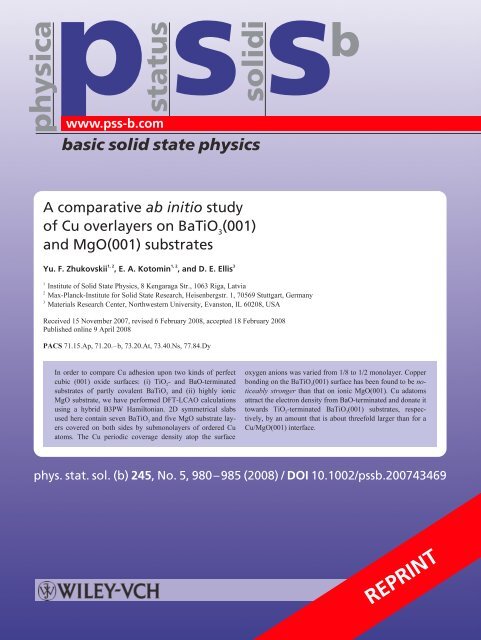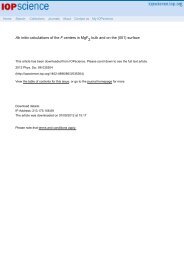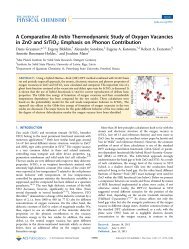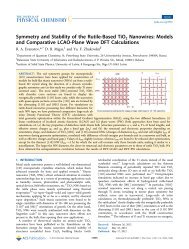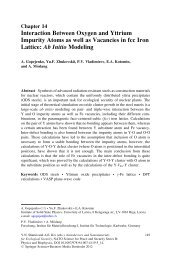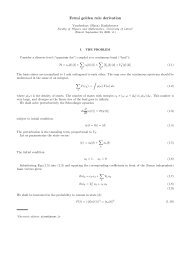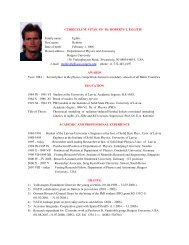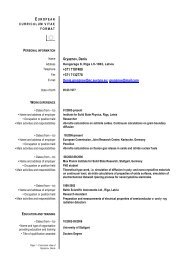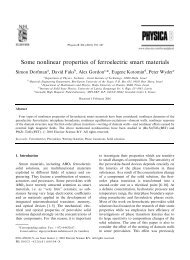View - Institute of Solid State Physics (ISSP), Riga, Latvia
View - Institute of Solid State Physics (ISSP), Riga, Latvia
View - Institute of Solid State Physics (ISSP), Riga, Latvia
Create successful ePaper yourself
Turn your PDF publications into a flip-book with our unique Google optimized e-Paper software.
DIEGESISInterdisziplinäres E-Journal für ErzählforschungInterdisciplinary E-Journal for Narrative Researchhttps://www.diegesis.uni-wuppertal.deWir bitten um Abstracts von max. einer halben DIN-A4-Seite bis spätestens zum30.9.2013. Bitte fügen Sie außerdem eine akademische Kurzvita bei. Schicken Sie beidesan die DIEGESIS-Redaktion: diegesis@uni-wuppertal.de (PD Dr. Matthias Aumüllerund Dr. Filippo Smerilli). Über die Annahme der Abstracts entscheiden Redaktionund Herausgeber bis zum 30.11.2013. Die Zusendung der fertigen Aufsätze imUmfang von ca. 15-20 Seiten, die vor der Publikation ein anonymisiertes Peer-Review-Verfahren durchlaufen, erwarten wir bis zum 30.06.2014. Der Erscheinungstermin desDIEGESIS-Themenhefts „Historische Narratologie“ ist im Dezember 2014.Wir suchen außerdem fortlaufend REZENSIONEN zu Neuerscheinungen aus allen Bereichender Erzählforschung (maximal der letzen 3 bis 4 Jahre), und zwar auch hier ausdrücklichdisziplinübergreifend, also nicht etwa nur aus den Philologien. Vorschläge fürRezensionen (in Form von einfachen Titelnennungen der zu besprechenden Bücher undergänzt durch kurze Informationen zum akademischen Lebenslauf) können jederzeit andie oben genannte Redaktionsadresse geschickt werden. In der Regel können wir Rezensionsexemplarebei den Verlagen besorgen.Über DIEGESIS:Das von der DFG geförderte E-Journal DIEGESIS. Interdisziplinäres E-Journal für Erzählforschung/ Interdisciplinary E-Journal for Narrative Research erscheint als Open-Access-Publikation ausschließlich im Internet (www.diegesis.uni-wuppertal.de).Der hohe wissenschaftliche Standard der in DIEGESIS veröffentlichten Forschungsbeiträgewird durch ein kompetitives Auswahlverfahren für Beiträge zu Themenheften sowieein Peer Review-Verfahren gesichert.Herausgegeben wird die Zeitschrift an der Bergischen Universität Wuppertal und inKooperation mit dem dortigen Zentrum für Erzählforschung (ZEF) (www.zef.uniwuppertal.de)von den Pr<strong>of</strong>essoren Matei Chihaia (Romanistik), Sandra Heinen(Anglistik), Matías Martínez (Germanistik), Michael Scheffel (AllgemeineLiteraturwissenschaft) und Roy Sommer (Anglistik).
OriginalPaperphys. stat. sol. (b) 245, No. 5 (2008) 983Table 1 A comparison <strong>of</strong> key properties for Cu/BaTiO 3andCu/MgO(001) interfaces; interfacial distances z Cu, adsoption energiesE ads, and charge transfer across the interface ∆q Cu(positivesign means excess <strong>of</strong> the electron density) for several surfacecoverages θ and different terminations.substrate term. θ, MLBaTiO 3MgOTiO 2BaOExpt. unknown 2.0–2.5[37](o)z , Å ECuads, eV ∆q Cu, e1/8 1.93 1.07 –0.151/4 1.96 0.99 –0.121/2 2.01 0.95 –0.091/8 1.97 0.99 –0.171/4 2.02 0.89 –0.141/2 2.07 0.90 –0.111/4 2.09 0.71 –0.051/2 2.11 0.73 –0.030.75[8]negligible[8]we could qualitatively check our results for Cu/BaTiO 3 assumingthat the ratio <strong>of</strong> the binding energies for Cu, Pd, Ptis qualitatively similar on ABO 3 and MgO surfaces. Theexperimental study [8] clearly shows that on the MgO(001) E ads (Cu) < E ads (Pd) < E ads (Pt). This is in a line withthe binding energies for Cu, Pd, Pt on MgO available fromrecent ab initio calculations (their ratio was found to be1 : 1.5 : 2.7, respectively [8]). Our estimate <strong>of</strong> the adsorptionenergy for Cu/BaTiO 3 interface (0.9–1.1 eV in Table1) is in qualitative agreement with this trend when weconsider the values calculated for Pd/SrTiO 3 (001) (2.5 eV[18]) and Pt/BaTiO 3 (001) (3.9 eV [16]) interfaces. Despitethe fact that the adsorption energy in Cu/MgO(001) interfaceis noticeably smaller as compared to that for both theterminations <strong>of</strong> Cu/BaTiO 3 interface (Table 1), the interfacialdistances are qualitatively similar to those calculatedearlier for various metals upon strontium and barium titanate(1.9–2.1 Å [16–19]).We found that for the same coverage densities, Cu adatomsare bound somewhat more strongly upon the TiO 2 -terminated surfaces than on the BaO termination, mainlydue to a strong influence <strong>of</strong> surface Ti ions. E ads decreasesslightly as the Cu coverage on TiO 2 termination increases(from 1.07 eV down to 0.95 eV) since the same surface Tiions should share intermetallic interactions with a largernumber <strong>of</strong> adatoms (Fig. 2a, b). Meanwhile, 1/2 Cu MLupon both BaO-terminated perovskite and MgO(001) substratesis bound slightly stronger as compared to 1/4 CuML, due to the additional attraction <strong>of</strong> the enhanced electronicdensity between the Cu atoms and the positivelycharged Ba 2+ or Mg 2+ ion below (Fig. 2f) as discussed recently[15].Although the outermost layers <strong>of</strong> both MgO(001) andBa-terminated BaTiO 3 (001) substrates possess similar geometry(cf. Fig. 1c, d vs. 1e, f, and notice a scaling factor∼ 2 by which the fcc MgO surface lattice parameter exceedsthat for sc BaTiO 3 ), the difference <strong>of</strong> their underlayersresults in a different mechanism <strong>of</strong> Cu adsorption: Tiions positioned under surface O ions and forming partlycovalent Ti–O bonds noticeably increase the reactivity <strong>of</strong>the BaO-terminated (001) perovskite surface as comparedto the MgO(001).To understand better the interface nature, we have examinedthe differential charge density plots for 1/4 and 1/2ML for both BaTiO 3 terminations. Figure 2a, b clearlyshow the polarization not only along the Cu–O 2- bond butalso between Cu atoms and surface Ti ions. As a result,each adatom donates up to 0.15e for both interfacial O anionand intermetallic Cu–Ti bonds. For Cu interfaces withBaO-terminated perovskite and MgO, Ba 2+ and Mg 2+ ionsare almost indifferent to the interfacial bonding, especiallyin the case <strong>of</strong> low (≤1/4 ML) coverage. However, O ions<strong>of</strong> the perovskite surface donate up to 0.17e to each Cuadatom vs. 0.05e from magnesia anions (Table 1). Similarqualitative conclusions were recently obtained for Me/BaTiO 3 (001) [16] where only BaO-termination was considered,Pd/SrTiO 3 (001) and Pt/SrTiO 3 (001) interfaces[18–20] although behavior <strong>of</strong> Pd and Pt adatoms on TiO 2 -terminated surface was found to be quite different.Analysis <strong>of</strong> the density <strong>of</strong> states (DOS) for copperoverlayers (Fig. 3) confirms substantial changes in conductionelectron distributions for different Cu coverages. TheO(2p) states are very sensitive to coverage variation. Forboth net-type coverages upon MgO(001) (1/4 and 1/2 ML),a pseudo-gap (the energy difference between the O(2p) andCu(3d) peaks) is well observed in Fig. 3e, f. These resultsare close to those <strong>of</strong> X-ray emission spectroscopy [39]where the gap between MgO and Cu peaks was found to be∼1 eV. Projections <strong>of</strong> Mg(3p) and Ba(6p) states showrather negligible contribution to the interaction on theCu/MgO(001) and Cu/BaTiO 3 (001) interfaces, respectively.Quite to the contrary, Ti(3d) states (which are not shownhere due to their absence on MgO substrate but whichcould be easily estimated as the difference between the totalDOS and DOS projected on O and Cu states) are veryactive in the interfacial interactions in the vicinity <strong>of</strong> theband gap; one may observe their different role at TiO 2 - andBaO-terminated substrates in Fig. 3a, d. For the TiO 2perovskite termination, a quite complicated DOS structureis observed where the Cu–O pseudo-gap grows with increasingCu coverage. On the BaO-terminated substrate,both O and Cu states are substantially shifted towardslower energies and, thus, the pseudo-gap is negative forboth coatings. This could result from the opposite chargetransfer across the interface discussed above (Table 1).Summing up, the conclusion can be drawn that DOS forboth Cu/BaTiO 3 (001) interfaces clearly shows a strong interfacialinteraction which reflects not only the polarization effects(physisorption) as in the case <strong>of</strong> a Cu/MgO(001) interfacebut also the chemisorption contribution.4 Conclusions The atomic and electronic structure <strong>of</strong>ordered Cu submonolayers with different coverages uponthe partly covalent BaTiO 3 (001) substrate (with BaO andTiO 2 terminations) as well as on the purely ionic MgO(001) substrate have been examined in this study usingwww.pss-b.com© 2008 WILEY-VCH Verlag GmbH & Co. KGaA, Weinheim
physicapssstatussolidib984 Y. F. Zhukovski et al.: A comparative ab inito study <strong>of</strong> Cu overlayers-10 -50a) 1.7 eVεeVb) -10 2.4 eV -50εeVεεc) -10 -50-0.5 eV eV d)-10 -5-1.4 eV0eVTotal DOSεεPDOS <strong>of</strong> interfacial O (2p)PDOS od interfacial Cu (3d)e)-10 -51.8 eV0eVf)-10 -51.6 eV0eVTotal DOS for pure substrate slabPDOS <strong>of</strong> interfacial O (2p) for puresubstrate slabFigure 3 (online colour at: www.pss-b.com) DOS, both total and projected on O (2p) and Cu (3d) energy states, in a comparison withsimilar DOS for perfect oxide substrates for six configurations <strong>of</strong> Cu over BaTiO 3and MgO as shown in Fig. 1: 1/4 and 1/2 Cu ML adsorptionover regular O 2− ions upon both TiO 2-terminated (a, b) and BaO-terminated (c, d) BaTiO 3(001) substrate and MgO(001) substrate(e, f). The largest peaks were normalized to the same value whereas a convolution <strong>of</strong> individual ε ienergy levels was plotted usinga Gaussian line shape with a half-width ∆ε = 0.5 eV.the formalism <strong>of</strong> hybrid B3PW DFT-LCAO calculations.The Cu–O interaction is found to be a driving force for astrong Cu adsorption on both defect-less oxide substrates.The contributions to the interfacial bonding from Ba andMg ions are almost negligible, even when Cu adatoms arelocated directly above these cations.In contrast, surface and subsurface Ti ions on the perovskitesubstrate substantially affect the Cu adsorption.On the TiO 2 -terminated BaTiO 3 surface, the partial intermetallicbonding between Cu adatoms and surface Ti ionsresults in a partial transfer <strong>of</strong> the electron density from theCu atoms towards the substrate (Fig. 1a, b and Table 1),unlike the other four configurations where Cu adatoms behaveas electron acceptors. (For Cu coatings >1/4 MLthese effects are less pronounced.)The analysis <strong>of</strong> DOS spectra shows that if the interactionbetween Cu and MgO could be still considered as physisorption(a strong polarization <strong>of</strong> interfacial Cu adatomsand O ions), the Cu adsorption on BaTiO 3 surface ratherreveals the chemisorption contribution, especially at aTiO 2 -terminated substrate. This conclusion is confirmed bythe magnitude <strong>of</strong> charge transfer across the Cu/BaTiO 3 interface,which exceeds that for Cu/MgO by a factor <strong>of</strong>about three.Acknowledgements This study was partially supported byboth the MRSEC program <strong>of</strong> the National Science Foundation(DMR-0520513) and the <strong>Latvia</strong>n National Program on FunctionalMaterials and Technologies for Microelectronics and Photonics(05.0005.1.1). DEE acknowledges support <strong>of</strong> DOE, throughGrant No. DE-FG02-05ER46255. The authors kindly thankD. Fuks, E. Heifets, and A. M. Stoneham for numerous fruitfuldiscussions. The technical assistance <strong>of</strong> S. Piskunov and Yu.Mastrikov was most valuable.© 2008 WILEY-VCH Verlag GmbH & Co. KGaA, Weinheim www.pss-b.com
OriginalPaperphys. stat. sol. (b) 245, No. 5 (2008) 985References[1] C. Noguera, <strong>Physics</strong> and Chemistry at Oxide Surfaces(Cambridge University Press, New York, 1996).[2] S. M. Murarka, I. V. Verner, and R. J. Gitmann, Copper –Fundamental Mechanisms for Microelectronic Applications(John Wiley and Sons, New York, 2000).[3] K. Uchino, in: Ferroelectric Ceramics, edited by M. Swain,R. W. Cahn, P. Hansen, and E. J. Kramer (VCH, Weinheim,1994), p. 635.[4] T. Mewes, M. Rickart, A. Mougin, S. O. Demokritov,J. Fassbender, B. Hillebrands, and M. Scheib, Surf. Sci. 481,87 (2001).[5] J. F. Scott, M. Azuma, C. A. Paz de Araujo, L. D. McMillan,M. C. Scott, and T. Roberts, Integr. Ferroelectr. 4, 61 (1994).[6] B. Psiuk, J. Szade, H. Schröder, H. Haselier, M. Mlynarczyk,R. Waser, and K. Szot, Appl. Phys. A 89, 451 (2007).[7] A. J. Francis and P. A. Salvador, J. Mater. Res. 22, 89(2007).[8] Y. Wang, E. Florez, F. Mondragon, and T. N. Truong, Surf.Sci. 600, 1703 (2006).[9] Y. Li, D. C. Langreth, and M. R. Pederson, Phys. Rev. B 52,6067 (1995).[10] N. Lopez, F. Illas, N. Rösch, and G. Pacchioni, J. Chem.Phys. 110, 4873 (1999).[11] A. V. Matveev, K. M. Neyman, I. V. Yudanov, andN. Rösch, Surf. Sci. 426, 123 (1999).[12] G. Geudtner, K. Jug, and A. M. Köster, Surf. Sci. 467, 98(2000).[13] V. Musolino, A. Selloni, and R. Car, J. Chem. Phys. 108,5044 (1998).[14] R. Benedek, D. N. Seidman, M. Mink<strong>of</strong>f, L. H. Yang, andA. Alavi, Phys. Rev. B 60, 16094 (1999).[15] Yu. F. Zhukovskii, E. A. Kotomin, D. Fuks, S. Dorfman,A. M. Stoneham, and G. Borstel, J. Phys.: Condens. Matter16, 4881 (2004).[16] F. Rao, M. Kim, A. J. Freeman, S. Tang, and M. Anthony,Phys. Rev. B 55, 13951 (1997).[17] Yu. F. Zhukovskii, S. Piskunov, E. A. Kotomin, O. Sychev,and G. Borstel, Microelectron. Eng. 81, 467 (2005).[18] T. Ochs, S. Köstlmeier, and C. Elsässer, Integr. Ferroelectr.32, 267 (2001).[19] T. Ochs and C. Elsässer, Z. Met.kd. 93, 406 (2002).[20] A. Asthagiri and D. S. Sholl, J. Chem. Phys. 116, 9914 (2002).[21] D. Fuks, E. A. Kotomin, Yu. F. Zhukovskii, and A. M. Stoneham,Phys. Rev. B 74, 115418 (2006).[22] D. Fuks, Yu. F. Zhukovskii, E. A. Kotomin, and D. E. Ellis,Surf. Sci. 600, L99 (2006).[23] Yu. F. Zhukovskii, D. Fuks, E. A. Kotomin, and D. E. Ellis,Nucl. Instrum. Methods Phys. Res. B 255, 219 (2007).[24] A. Bogicevic and D. R. Jennison, Surf. Sci. 515, L481 (2002).[25] M. E. Lines and A. M. Glass, Principles and Applications <strong>of</strong>Ferroelectrics and Related Materials (Clarendon Press, Oxford,1977).[26] E. Heifets, R. I. Eglitis, E. A. Kotomin, J. Maier, andG. Borstel, Phys. Rev. B 64, 235417 (2001).[27] V. R. Saunders, R. Dovesi, C. Roetti, R. Orlando, C. M. Zicovich-Wilson,N. M. Harrison, K. Doll, B. Civalleri,I. J. Bush, Ph. D’Arco, and M. Llunell, CRYSTAL-03 UserManual, University <strong>of</strong> Turin (2003).[28] A. D. Becke, J. Chem. Phys. 98, 5648 (1993).[29] A. D. Becke, Phys. Rev. A 38, 3098 (1988).[30] J. P. Perdew and Y. Wang, Phys. Rev. B 45, 13244 (1992).[31] S. Piskunov, E. Heifets, E. A. Kotomin, J. Maier, R. I. Eglitis,and G. Borstel, Surf. Sci. 575, 75 (2005).[32] P. J. Hay and W. R. Wadt, J. Chem. Phys. 82, 299 (1985).[33] Yu. F. Zhukovskii, E. A. Kotomin, and G. Borstel, Vacuum74, 235 (2004).[34] Yu. F. Zhukovskii, E. A. Kotomin, D. Fuks, and S. Dorfman,Superlattices Microstruct. 36, 63 (2004).[35] A. D. Polli, T. Wagner, T. Gemming, and M. Rühle, Surf.Sci. 448, 279 (2000).[36] T. Wagner, G. Richter, and M. Rühle, J. Appl. Phys. 89,2606 (2001).[37] S. Colonna, F. Arciprete, A. Balzarotti, M. Fanfoni, M. DeCrescenzi, and S. Mobilio, Surf. Sci. 512, L341 (2002).[38] P. W. Tasker, J. Phys. C, <strong>Solid</strong> <strong>State</strong> Phys. 12, 4977(1979).[39] P. Jonnard and C. Bonnelle, Surf. Sci. 436, L724 (1999).www.pss-b.com© 2008 WILEY-VCH Verlag GmbH & Co. KGaA, Weinheim


